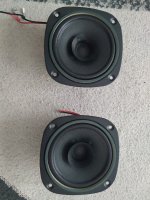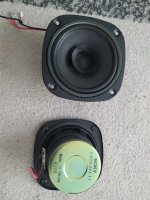There are two Lii Audio......it's become a bit of a $hiT show over in China......start a separate post about the driver but just remember, an 8" full range driver will have pretty poor off axis performance above 3khz so be prepared to sit down and listen.
At first, start playing with cheap ones, different sizes, to get a taste of what you may like or not. It is less painful to start modifying/destroying cheap fullrange speakers, to get some experience.
For example, today I got a Sony front loudspeaker for free (junkyard). Guess what was inside:
For example, today I got a Sony front loudspeaker for free (junkyard). Guess what was inside:
Attachments
why would one put the full range driver (mid / upper FR) in a smaller baffle area
There's also a directivity factor, which I believe was the main driver of narrower baffles on some of the newer style dipoles.the difference lies in what what many like to call diffraction
http://musicanddesign.speakerdesign.net/Dipoles_and_open_baffles.html
"The polar response of the dipole, far from the center of the dipole, is as shown in Figure 3 as a function of the separation divided by wave length, w. For long wavelengths, (low frequency) d/W is small and the radiation pattern is the classical dipole figure 8. This pattern remains fairly constant up to about d/w = 0.25, or an octave below the dipole peak. Above d/w = 0.25 the radiation pattern initially broadens up to about d/w = 0.66 with an off axis bulge before degenerating into a multi-lobed response. The number of lobes above d/w = 1.0 will increase as the value of d/w increases. Figure 3 shows the result for d/w = 1. which corresponds the frequency of the first null above the dipole peaks in Figure 2."
http://gainphile.blogspot.com/2011/01/measuring-open-baffle-loudspeakers.html
"Decide baffle width
It is a compromise between SPL and polar response and the general rule of thumb is baffle width should be narrower than 2x diameter of the midrange."
Any experience and ideas about this driver?
No direct experience but i would not touch with 10 foot pole.
dave
At first, start playing with cheap ones, different sizes, to get a taste of what you may like or not.
Very wize suggestion.
dave
Thanks again for all your replies and suggestions! The directivity explanation by @mattstat makes it clearer why one would restrict baffle width. I will read the linked article about radiation patterns.
I will restrict to a cheaper driver, so I think I will just give either the Markaudio PLUVIA-7HD or the Dayton Audio PS95 a try - I think I will go for the Pluvia and try to match it with my Peerless SLS 315 woofers - I have a MiniDSP 2x4 HD DSP and two stereo amplifiers.
I will restrict to a cheaper driver, so I think I will just give either the Markaudio PLUVIA-7HD or the Dayton Audio PS95 a try - I think I will go for the Pluvia and try to match it with my Peerless SLS 315 woofers - I have a MiniDSP 2x4 HD DSP and two stereo amplifiers.
Last edited:
Markaudio PLUVIA-7HD or the Dayton Audio PS95
I suspect the P7HD would be a significant step up from the Dayton/PE part.
dave
Anyone tried Pluvia 7 PHD (4 ohm version)?
Yes. It is voiced for Japan like the CHN-70 and usually is not to western taste.
dave
Hi, I just experimented with Edge: I have a pair of DIY OB woofer panels, which have 6 Dayton RS-180-4 drivers per channel: the panels are about 22 cm wide and have tapered wings on both sides. I used them as a LF woofer together with my DIY electrostatic loudspeakers. But at the moment I don't use them anymore so I can exeriment with them, just like my Peerless SLS 315 drivers.
The OB tower is about 22 cm wide and about 120 cm high. Although placing the new PLUVIA-7HD on top of this panel will be a bit too high positioned (?), 120 - 130 high, it would be an easy experiment. So I simulated the baffle and the 4 inch Pluvia driver in Edge. I placed the driver at the top corner of the baffle, but I also placed it just outside the baffe, above it. If I'm correct, the freqency and phase response look even better when placing the driver outside above the baffle:


The red line is the driver outside / above the baffle, the green line is the driver in the baffle.
Is this a correct conclusion and if so, why is output below 400 Hz better when the driver is hung in free air, compared to mounted in a finite baffle?
The OB tower is about 22 cm wide and about 120 cm high. Although placing the new PLUVIA-7HD on top of this panel will be a bit too high positioned (?), 120 - 130 high, it would be an easy experiment. So I simulated the baffle and the 4 inch Pluvia driver in Edge. I placed the driver at the top corner of the baffle, but I also placed it just outside the baffe, above it. If I'm correct, the freqency and phase response look even better when placing the driver outside above the baffle:
The red line is the driver outside / above the baffle, the green line is the driver in the baffle.
Is this a correct conclusion and if so, why is output below 400 Hz better when the driver is hung in free air, compared to mounted in a finite baffle?
A vertical line of 6 RS180 will place your fullrange driver well above seated ear height and given the poor off axis response of mid/tweeters, I’d put this one to bed unless you do a side by side slot load.
@mayhem13 thanks for your suggestion - I will just start to experiment with 2 SLS 315 drivers and put the FR driver on top, as the top location will be at seated ear height.
I'm still curious about placing the FR driver "free", so outside the baffle, compared to inside the baffle. According to my simulations the first option - outside - looks like it produced better phase response and more extension below 400 Hz?
I'm still curious about placing the FR driver "free", so outside the baffle, compared to inside the baffle. According to my simulations the first option - outside - looks like it produced better phase response and more extension below 400 Hz?
The less baffle the better for upper mids and highs
You 'could' segment the driver across the baffle top with half fixed to the baffle and the other half completely in free air......i nice mix of the two phase sums and a little more lower end directivity
You 'could' segment the driver across the baffle top with half fixed to the baffle and the other half completely in free air......i nice mix of the two phase sums and a little more lower end directivity
Hi again! Two days ago I received the Pluvia's and I made two OB loudspeakers: just a 34x80 cm baffle for the two Peerless SLS 12 drivers per channel, and on top of it a small baffle of 14x18cm, just horizontally aligned to the woofer baffle.
First impression was very positive; I was not 100% confident about the outcome, both because of the magnetic driver; I was used to a DIY electrostatic full range panel, so a 55 euro FR driver sounds like a step back. Also a lack of experience would be a factor.
But even with the first quickly made DSP filter the result was very nice: enough warmth and low frequency range, combined with a nice mid / high.
But after hearing a record with mainly voices I got a bit disappointed as it started to sound a bit dull / veiled. Maybe it was me missing the electrostatic sound?
But I was aware of a declining slope towards 20 kHz. So I tweaked the PEQ filters again - now everything sounded much brighter and defined - but also too agressive. ("hot"?)
So I did some more tweaking and got a fairly straight response. The veil has disappeared; the low frequencies make a lot of impact - even though I just used a plain open baffe without U or H framing... The design is very simple, a feature I like. It seems this is an acceptable replacement for my stats; my stats are a bit more detailed, but run into problems with high dynamic range recordings, just because their sensitivity is inherently low and dropped after a few years. I don't this behaviour using "normal" magnetic cone drivers.
So I'm surprised by the quality such affordable, small drivers can produce in such a simple setup.
Tomorrow I will post a few photos!
Below is a frequency response measured at 1 meter distance in my living room:

Not sure how good the cross-over is, it's crossed over at 300 / 350 Hz. I needed a lot of equalizing for the FR driver, also around 10 kHz where there were some steep raises...
First impression was very positive; I was not 100% confident about the outcome, both because of the magnetic driver; I was used to a DIY electrostatic full range panel, so a 55 euro FR driver sounds like a step back. Also a lack of experience would be a factor.
But even with the first quickly made DSP filter the result was very nice: enough warmth and low frequency range, combined with a nice mid / high.
But after hearing a record with mainly voices I got a bit disappointed as it started to sound a bit dull / veiled. Maybe it was me missing the electrostatic sound?
But I was aware of a declining slope towards 20 kHz. So I tweaked the PEQ filters again - now everything sounded much brighter and defined - but also too agressive. ("hot"?)
So I did some more tweaking and got a fairly straight response. The veil has disappeared; the low frequencies make a lot of impact - even though I just used a plain open baffe without U or H framing... The design is very simple, a feature I like. It seems this is an acceptable replacement for my stats; my stats are a bit more detailed, but run into problems with high dynamic range recordings, just because their sensitivity is inherently low and dropped after a few years. I don't this behaviour using "normal" magnetic cone drivers.
So I'm surprised by the quality such affordable, small drivers can produce in such a simple setup.
Tomorrow I will post a few photos!
Below is a frequency response measured at 1 meter distance in my living room:
Not sure how good the cross-over is, it's crossed over at 300 / 350 Hz. I needed a lot of equalizing for the FR driver, also around 10 kHz where there were some steep raises...
Two days ago I received the Pluvias
I would not obsess about measuring and EQ until you have given the P7HD some 100 hours of gentle break-in. They will change and the sound will become more refined over that period of time.
dave
- Home
- Loudspeakers
- Full Range
- DIY full range OB

